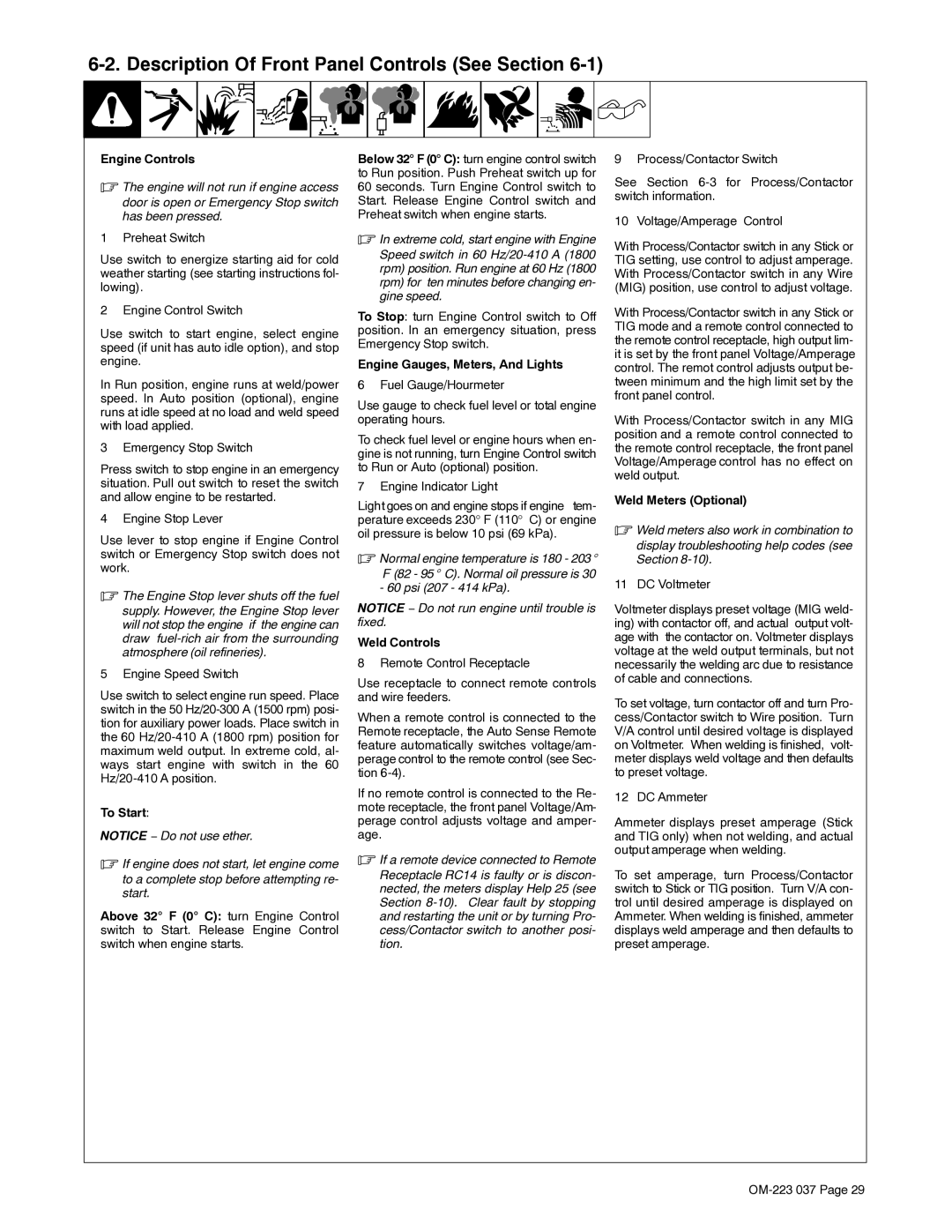
6-2. Description Of Front Panel Controls (See Section 6-1)
Engine Controls
.The engine will not run if engine access
door is open or Emergency Stop switch has been pressed.
1 Preheat Switch
Use switch to energize starting aid for cold weather starting (see starting instructions fol- lowing).
2 Engine Control Switch
Use switch to start engine, select engine speed (if unit has auto idle option), and stop engine.
In Run position, engine runs at weld/power speed. In Auto position (optional), engine runs at idle speed at no load and weld speed with load applied.
3 Emergency Stop Switch
Press switch to stop engine in an emergency situation. Pull out switch to reset the switch and allow engine to be restarted.
4 Engine Stop Lever
Use lever to stop engine if Engine Control switch or Emergency Stop switch does not work.
.The Engine Stop lever shuts off the fuel supply. However, the Engine Stop lever will not stop the engine if the engine can draw
5 Engine Speed Switch
Use switch to select engine run speed. Place switch in the 50
To Start:
NOTICE − Do not use ether.
.If engine does not start, let engine come
to a complete stop before attempting re- start.
Above 325 F (05 C): turn Engine Control switch to Start. Release Engine Control switch when engine starts.
Below 325 F (05 C): turn engine control switch to Run position. Push Preheat switch up for 60 seconds. Turn Engine Control switch to Start. Release Engine Control switch and Preheat switch when engine starts.
.In extreme cold, start engine with Engine
Speed switch in 60
To Stop: turn Engine Control switch to Off position. In an emergency situation, press Emergency Stop switch.
Engine Gauges, Meters, And Lights
6 Fuel Gauge/Hourmeter
Use gauge to check fuel level or total engine operating hours.
To check fuel level or engine hours when en- gine is not running, turn Engine Control switch to Run or Auto (optional) position.
7 Engine Indicator Light
Light goes on and engine stops if engine tem- perature exceeds 230° F (110° C) or engine oil pressure is below 10 psi (69 kPa).
.Normal engine temperature is 180 - 2035 F (82 - 955 C). Normal oil pressure is 30
-60 psi (207 - 414 kPa).
NOTICE − Do not run engine until trouble is fixed.
Weld Controls
8 Remote Control Receptacle
Use receptacle to connect remote controls and wire feeders.
When a remote control is connected to the Remote receptacle, the Auto Sense Remote feature automatically switches voltage/am- perage control to the remote control (see Sec- tion
If no remote control is connected to the Re- mote receptacle, the front panel Voltage/Am- perage control adjusts voltage and amper- age.
.If a remote device connected to Remote
Receptacle RC14 is faulty or is discon- nected, the meters display Help 25 (see Section
9 Process/Contactor Switch
See Section
10 Voltage/Amperage Control
With Process/Contactor switch in any Stick or TIG setting, use control to adjust amperage. With Process/Contactor switch in any Wire (MIG) position, use control to adjust voltage.
With Process/Contactor switch in any Stick or TIG mode and a remote control connected to the remote control receptacle, high output lim- it is set by the front panel Voltage/Amperage control. The remot control adjusts output be- tween minimum and the high limit set by the front panel control.
With Process/Contactor switch in any MIG position and a remote control connected to the remote control receptacle, the front panel Voltage/Amperage control has no effect on weld output.
Weld Meters (Optional)
.Weld meters also work in combination to
display troubleshooting help codes (see Section
11 DC Voltmeter
Voltmeter displays preset voltage (MIG weld- ing) with contactor off, and actual output volt- age with the contactor on. Voltmeter displays voltage at the weld output terminals, but not necessarily the welding arc due to resistance of cable and connections.
To set voltage, turn contactor off and turn Pro- cess/Contactor switch to Wire position. Turn V/A control until desired voltage is displayed on Voltmeter. When welding is finished, volt- meter displays weld voltage and then defaults to preset voltage.
12 DC Ammeter
Ammeter displays preset amperage (Stick and TIG only) when not welding, and actual output amperage when welding.
To set amperage, turn Process/Contactor switch to Stick or TIG position. Turn V/A con- trol until desired amperage is displayed on Ammeter. When welding is finished, ammeter displays weld amperage and then defaults to preset amperage.
